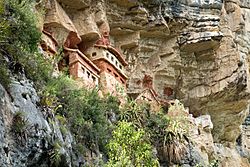Revash facts for kids
 |
|
| Lua error in Module:Location_map at line 420: attempt to index field 'wikibase' (a nil value). | |
| Location | Luya Province, Amazonas |
|---|---|
| Type | Necropolis |
| History | |
| Founded | 14th century AD |
| Periods | Late Intermediate |
| Cultures | Chachapoya |
The Revash burial site is in Peru. It's located in the Santo Tomás District of Luya Province. This area is about 60 kilometers (37 miles) south of Chachapoyas.
The ancient buildings are high up in the mountains. They sit about 2,800 meters (9,200 feet) above sea level. You can find them on the limestone rock of Carbon Hill. This hill is on the left side of the Alto Utcubamba Valley. The San José de Laumar River is to its southeast.
Contents
What are the Revash Mausoleums?
The Revash mausoleums are ancient buildings found in the Amazonas region of Peru. They are special structures where people from the past were buried. These amazing buildings are like tiny houses built into cliffs.
Who Discovered and Studied Revash?
A long time ago, in the last century, Charles Wiener found similar burial sites in the Utcubamba area. Later, archaeologists Henry and Paule Reichlen studied the Revash mausoleums in Santo Tomás. They focused on Revash because the roof of one mausoleum had fallen. This protected many old cultural items inside.
Between 1983 and 1986, the Antisuyo expeditions explored the area. They were part of the Amazon Archaeology Institute. These teams found and recorded many other undiscovered mausoleum groups. Some were in Ochín and other nearby places.
How are Revash Mausoleums Different from Others?
Other types of burial containers, called sarcophagi, exist in a place called La Petaca. These are different from the Revash mausoleums. The sarcophagi in La Petaca are found on cliffs. They look like small houses stuck to the rock. Their walls were not finished in the same way as the Revash mausoleums.
How Were the Revash Mausoleums Built?
The Revash burial buildings are lined up along a narrow space. This space was carved into the rocky wall of a huge canyon. Most of them are still standing. Sadly, the mummies inside were destroyed by rodents or stolen a long time ago.
What Do the Mausoleums Look Like?
The mausoleums look like small houses grouped together. They form miniature "villages" on the cliffside. They have a curious similarity to the "cliff-houses" found in Colorado. Both types of structures are small houses built into rock formations. However, these similarities are just a coincidence.
Were They for One Person or Many?
From the bones found inside, it seems the Revash mausoleums were not for single burials. Instead, they were likely used as collective tombs. This means many people were buried together. It is thought that these were important and powerful people.
What About the Roofs and Walls?
The sloping roofs of the mausoleums were mostly for show. Since they were protected by the cave, the roofs didn't need to keep out rain or sun. The builders just made them look like real roofs. They used mud, sticks, and reeds to create a quincha style.
The walls of the mausoleums were built with stones held together by mud mortar. Each building has a rectangular base. They can have one or two floors. Instead of a front door, they have side doors. They are often attached to dividing walls or share a common wall. The back side doesn't have a wall because the mausoleums were built right against the rock.
Art and Symbols in the Mausoleums
The Revash burial houses have decorative moldings around the top of their walls. These walls are painted with different figures. You can see felines (like big cats), South American camelids (like llamas), people, and two-color circles. These paintings are clearly part of the mausoleums.
The walls also have art made by cutting into the stone itself. These designs include shapes like a T, crosses, and rectangles. The cross symbols look similar to those used in the coastal architecture of the Virú culture. We don't know what these symbols mean yet. However, the cross shapes are identical to those on the side walls of the church in La Jalca. Local stories say a mythical figure called Juan Oso, or "small bear," built that church.
When Were the Revash Mausoleums Built?
The mausoleums of the Chachapoyas culture do not show any Inca cultural influences. This suggests they were built before the Inca Empire expanded into this area.
In 1950, Paule and Henry Reichlen thought the mausoleums might be from the 14th century C.E. They also believed these structures were connected to a type of burial architecture called chullpa. Chullpas were common in ancient Peru during the Tiahuanaco-Huari period, around 1000 C.E.
Images for kids
See also
 In Spanish: Mausoleos de Revash para niños
In Spanish: Mausoleos de Revash para niños


